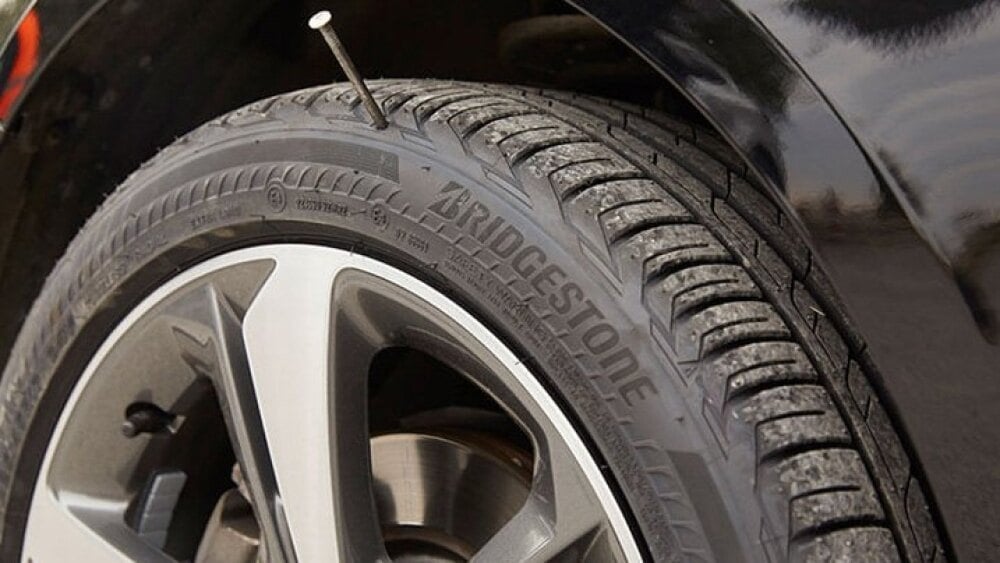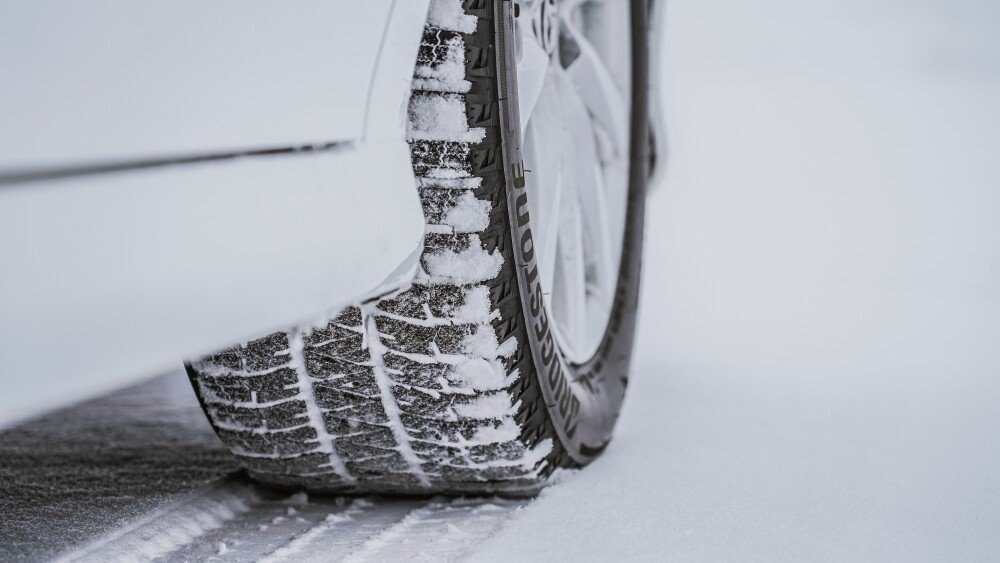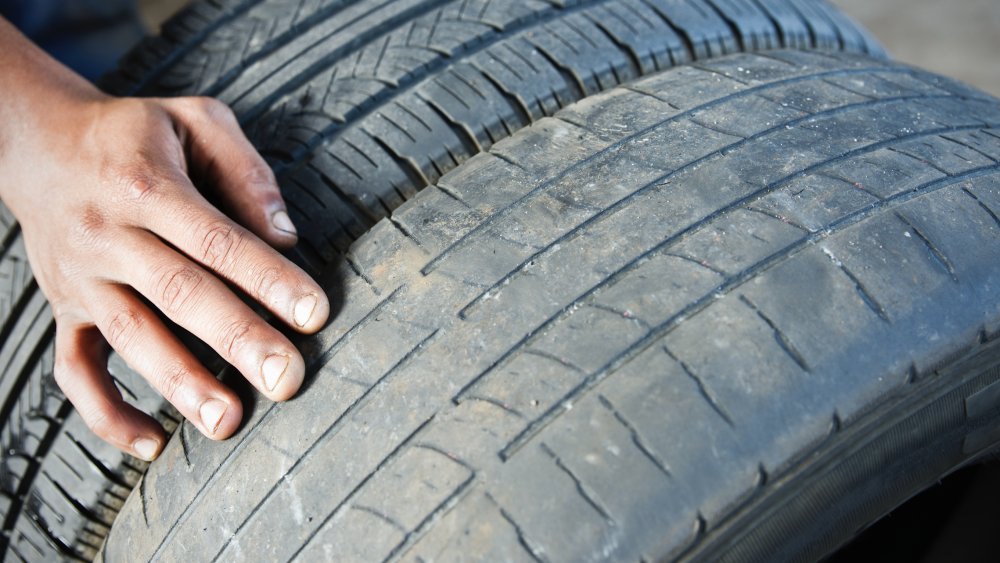The Short Version: Maintaining your vehicle’s tires is one of the most critical safety checks you can do as a driver. Our guide will give you some common sense directions about when to replace tires and how to check for critical factors like tread depth, age, or damage.
As a lifelong auto enthusiast and a tester and reviewer of new vehicles for the last two decades, I’m a huge believer in having good-condition, season- and surface-correct tires on all of my vehicles at all times. Without proper rubber a car can’t stop, go, or change direction effectively, which can not only drastically reduce driver safety, it can also seriously curtail driving enjoyment.
I am the resident “car guy” for many of my friends and family, and one question I hear a lot is, “How do I know if I need new tires?” In this article, I’ll try to give you the same straightforward advice I’d give my neighbor or my Mom about when to replace your tires, as well as some information about seasonal tires, tire damage, how tires are constructed, and more.
Of course, I’m a journalist and not an engineer, so I also reached out to Ian McKenney, a senior project manager at Bridgestone Americas, for some expert advice on how to maintain and when to replace your car’s rubber.
This stuff is important. In 2022 the U.S. National Highway Traffic Safety Administration reported that 562 fatalities stemmed from tire-related crashes. Read on to get a better idea of how to keep yourself and everyone who rides in your car, safe.
When To Replace Your Tires?
Like many automotive maintenance concerns, knowing when to replace your tires can be guided by rules of thumb, but the specifics about wear, age, dry rot, and damage always matter most.
“Multiple factors play a role in how long a tire may remain in service,” says McKenny. “Miles driven, road conditions, driving style, maintenance and age all affect how long a tire lasts.”
Here are the basics.
Treadwear And Tread Depth

Road tires rely on expertly designed grooves in the rubber known as treads to work properly. Treads afford grip on a variety of surfaces of the road, in all kinds of weather, and the more they wear down, the less grip your vehicle will have (unless you’re on a racetrack!).
Tread depth is one of the most important things to pay attention to when inspecting your tires. The good news is that, according to McKenny, you can do a quick check with a penny to know where your treads are at:
“An easy way to know when it’s time to replace a set of tires is by evaluating tread depth with the penny test. All you have to do is turn a penny upside down and dip it into the tread of your tires. If Lincoln’s head is fully visible, it’s time for new tires. Drivers should replace their tires when they don’t have enough tread to safely grip the road.”
You may have also heard similar advice based on a U.S. quarter. In that case look to see if George Washington’s upside-down head is level with the tread, indicating 4/32s of an inch of depth (or more if his head is covered by the tread).
Tire Age

Tires that are used regularly will likely have worn treads before age becomes a factor. But old tires can be risky for those who don’t drive many miles or keep cars in storage.
“We recommend changing tires by year 10, even if they don’t have many miles on them,” says McKenny. “Unused tires also deteriorate over time and can develop cracks that make tires unsafe to use. Therefore, even if a set of tires has not been driven on for many miles, driving on tires over 10 years old is inadvisable.”
How To Know The Week and Year Any Tire Was Manufactured
A quick and easy way to find out the precise age of any tire sold in the U.S. is to look for a four-digit DOT (Department of Transportation) marking on the sidewall. This four-digit number refers to the week and year a tire was manufactured. For example, a “3507" means that tire was produced during the 35th week of 2007. Note that while many tires will have the date code on the outside-facing sidewall, there are cases where you’ll need to look at the inward-facing side to see the number.
Tire Damage
Spotting visible signs of damage on your tires is equally important to observing treadwear, if not more. As you look over your tires for the following signs of trouble, remember to inspect the inboard edge of the sidewalls, which is often overlooked.
Dry Rot
Direct sunlight, UV rays, and ozone in the atmosphere all react with rubber in automotive tires, causing the compounds to dry up, harden, and even crack over time. For this reason, a rarely driven vehicle can be even more susceptible to what is known as “dry rot.”
When a tire reaches five years of age, it’s smart to make a close examination of the sidewalls, which is where you’ll see dry rot’s telltale cracking start to develop first. (Don’t forget to check the spare as well.)
The safety issue most likely to occur with older, dry-rotted tires is that steel belt reinforcements within the tire can shift out of place when rubber hardens to the point where it’s no longer flexible enough to hold things together. A belt shifting may cause a blowout while driving, or it can create a sudden and horrendous vibration in that tire.

Tire Punctures
“If there is a nail in a tire, patching it up is sufficient,” says McKenny, “as long as the puncture is less than 1/4 inch in diameter and occurs in the tread area.”
If the puncture is larger, located in the sidewall or shoulder of the tire, or there are multiple punctures, it’s smarter and safer to replace the tire completely.
It’s important to note that run-flat tires do not hold plugs well because their harder rubber blend does not allow the flexibility required. If you’ve got a puncture anywhere on a run-flat tire, you’ll need to replace it. Tire warranties purchased for run-flat tires will typically cover replacement due to puncture.
Sidewall Blisters
Blisters on a tire sidewall are a result of trauma – usually caused by a deep pothole, curb, or hard speed bump hit. After the initial impact squeezes the tire against the rim, the inner lining of the tire is cut. Air then leaks in between inner and outer sidewall areas in a concentrated pocket, forming a visible swelling. Blisters can range in size from a small bulge to a large bubble that looks ready to pop any second.
Damage From Driving An Underinflated Tire
If you’ve been forced to drive on an underinflated tire for any amount of time it’s important to check for damage ASAP.
Driving on a “low” tire can cause critical damage. Friction is created by sections of the inner sidewall rubbing together once the tire has collapsed upon itself, which can in turn shred the sidewall internally.
When this happens you may notice a ring around the tire where rubber has become visibly shredded on the outside. Or, you may see what appears to be a cut line around the outer sidewall.
Regardless of exactly how inner sidewall damage manifests itself on the outside, the tire has become too compromised for continued safe use. Replace it as soon as possible, because continuing to drive on it can result in a blowout.
Opportune Times To Replace Tires

Tires are critical safety equipment but they’re not inexpensive. Still, it’s often in your best interest to replace them as a pair of two or as a set of four, even if only one tire “failed.”
If all four of your tires are relatively new and unworn when you suffer a complete failure to just one tire, it’s probably ok to replace just one corner. Otherwise, at a minimum, tires should be purchased in pairs per axle, or you’ll risk uneven handling, grip, and wear to the rest of the tires on the car. And on cars with all-wheel drive, it’s best to replace all four tires at once to protect the center differential from premature wear.
Seasonal changes – if you live in a place that gets snow, especially, like I do – are always a good time to evaluate tire condition.
Tire Construction
Modern passenger car tires feature a “steel belted radial” design that was first developed in the 1940s. Known simply as radial tires, these contain a series of radial plies mounted across the tire from left side to right - perpendicular to the direction the tire travels. Compared to older “bias ply” tires that laid the plies out diagonally, radial tires generate less heat, last longer, and provide superior ride quality thanks to more flexible sidewalls.
What Is A Treadwear Rating?
Earlier in this guide, I wrote about how to check the treads on your existing tires, but when purchasing new or replacement tires, understanding the treadwear rating is important.
Treadwear ratings are generally a good indicator of how rapidly a tire will wear. By law, passenger car tires sold in the U.S. must display a treadwear rating number on their sidewall. Note that this rule is not mandatory for off-road tires, tires designed for trailers, or temporary spares.
Uniform Tire Quality Grade standards (UTQG) were specified to create a uniform rating system for consumer tires when it comes to treadwear, temperature resistance, and traction ability. This test utilizes a 7,200-mile testing cycle, with wheel alignments, tire rotations, and pressure adjustments performed every 800 miles.
A control tire for this testing protocol, called a “course monitoring tire,” is given a base wear level of 100. A tire that would last twice as long as the control tire is rated at 200, and a tire that would last five times as long would be rated 500.
Generally, tires made of harder rubber compounds to achieve a lower rolling resistance (for higher fuel efficiency) will score the highest treadwear ratings of around 700 to 800. Conversely, performance tires designed for road-holding or racing will have the lowest treadwear ratings (below 100 in extreme cases) because their rubber is made of a stickier, softer compound that gets scrubbed off faster.
Understanding Treadwear Patterns

For those of you looking for an advanced course in treadwear knowledge, Senior Product Manager Ian McKenney at Bridgestone has some notes on different wear patterns and what issues they may indicate on your vehicle.
- Edge Wear: “When the shoulders of the tire closest to the rims wear down and the tread in the center of the tire remains the same, the tires may be underinflated. This wear pattern indicates that the tire shoulders are making firm contact with the road and withstanding excess friction. To remedy the issue, consider adjusting the tire pressure and adding air to the tires.”
- Center Wear: “Excess wear in the center of a set of tires means they are over-inflated. Too much air in tires can also lead to a loss of traction and a bumpy ride.”
- Inner or Outer Shoulder Wear: “If one shoulder is wearing down more quickly than the rest of the tire, it’s likely due to an alignment issue. It could indicate the toe (the inward or outward angle of the tires when viewed from above) or the camber (the inward or outward angle of your tires when viewed from the front) hasn’t been set properly.”
- Cupping or Scalloping: “Cupping or scalloping wear appears as sporadic patches of wear across the whole tire. The worn sections are usually 3-4 inches in diameter and can indicate an issue with the suspension. The suspension should prevent the tires from bouncing up and down, but if the vehicle’s shocks, struts or bushings are worn out, they won’t be able to do their job. The inability for the tires to roll smoothly against the road is what causes varied wear.”
- Patchy, Diagonal Wear: “Random tread wear that presents no obvious pattern is due to going too long between tire rotations. A tire rotation and balancing service is suggested every 5,000 miles because switching the position of your tires helps create even wear across all four tires.”
Buying New Tires on CARiD
CARiD has a Shop by Service Type tool that lets customers search for the type of work a vehicle needs and select the make, model, and year. The site shows exactly the parts needed for a job. There’s also a similar method for finding all kinds of tires that fit perfectly, by selecting your vehicle, tire type, and brand.
I hope that this tire guide has left you better informed about how to check your own tires, and confident in the knowledge of what to do when it’s time to replace them. Don’t let worn or damaged tires impact your safety, or curtail the joy of driving your favorite car.
FAQ
At what tread depth do your tires need to be replaced?
Tires with treads worn down to 4/32s of an inch or less should be replaced. Or, if your tires were manufactured 10 years ago (or more), they should be taken out of service and replaced.
How often should I replace my tires?
Experts recommend that tires 10 years old or older should be replaced. However, a tire could easily wear down to an unsafe level of tread depth in less than ten years. It’s important to regularly evaluate the overall condition of your tires, not just rely on their age or the number of miles they’ve been in service.
How long do tires last?
Multiple factors play a role in how long a tire may remain in service: Miles driven, road conditions, driving style, maintenance, and age all affect how long a tire lasts. Generally speaking, experts recommend that tires manufactured 10 years prior (or longer) be taken out of service and replaced.
How many miles are tires good for?
The number of miles you can expect from a set of tires is quite variable, with the tire’s construction, treadwear rating, driving style, frequently encountered road conditions, and maintenance all playing a part. Some extreme-performance tires have warranties that run to 25,000 or 30,000 miles, while much harder compound tires could be rated for 80,000.
Should I replace tires with 4/32 of an inch of tread?
Experts use 4/32 of an inch as the baseline for acceptable tread depth. Treads worn down to lower than that level should be replaced with new tires for the safe operation of a vehicle.
